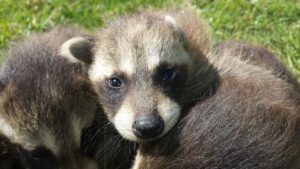Learn About Individual Animals
When introducing children to animal education, we recommend starting with facts about the creatures themselves. Learning interesting information about each species tends to catch children's attention and allows them to relate to each animal. This makes them more likely to listen and understand when you talk about wildlife being afraid of people and biting or scratching in self-defense.Raccoons
- Raccoons are omnivorous, which means that they eat plants and animals. Raccoons eat fruits, nuts, berries, bird eggs, insects, fish, and frogs. When they live close to cities, they also eat scraps of human food that is thrown in the trash.
- Their babies are called kits.
- These creatures are nocturnal, which means they are awake at night and sleep during the day.

Mice
- These small rodents are also omnivores. Mice eat grass, seeds, fruits, nuts, small insects, and animals they find that are already dead. When mice live in cities, they like to eat people’s food from the trash, and they can even get treats from cupboards because they can bite boxes and bags open with their sharp teeth.
- Their babies are called pups.
- Mouse teeth never stop growing. They find hard things to bite to file their teeth down.

Squirrels
- Squirrels are also omnivores - squirrels eat fungi, seeds, fruits, nuts, eggs, insects, and sometimes even small snakes.
- Their babies are called kits.
- Squirrels wrap their big fluffy tails around themselves like a coat to keep warm when it’s cold. They also use their tails to help them balance and to communicate with other squirrels.
Skunks
- Skunks are omnivores as well. They eat insects, mice, reptiles, birds, grass, leaves, nuts, and roots.
- Skunk babies are also called kits.
- They can hear and smell better than us, but they can’t see very well, and they are also not very good at climbing.

Bats
- These mammals are omnivores too. They mainly eat insects, but they also drink juice from fruit and nectar from flowers.
- Their babies are called pups.
- Bats are not actually blind, they can see just as well as us humans. They do use their ears for echolocation, which means that they make a loud noise, and the noise bounces off things to tell them where they are. Bats have excellent hearing.




